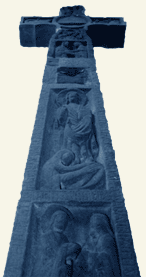
The Dream of the Rood is part of the 10th century Vercelli Book, but the text itself is older. Part of it is chiselled as runic text onto the Ruthwell Cross of Northumbria, which stems from the early eighth century. The image on the left is a photograph of the cross, and the text can be seen as lines in the frames around the reliefs.
According
to Keenan, the poem 'shows an affinity with Elene in that both are discoveries
of the cross. The discovery in Elene is pseudo-historical; that
in the Dream is visionary.'![]()
In fact, the Dream of the Rood is the earliest English dream-vision.
It is divided into three parts - the vision of the Cross, its speech
and the concluding reflections of the dreamer.
The role of the Cross formulates an interesting paradox: The Cross serves as a faithful retainer, but in order to obey its Lord, it has to become his slayer.
The poem has quite a few apocalyptic elements. One of those is the idea of the Cross as a salvatory instrument before judgement.